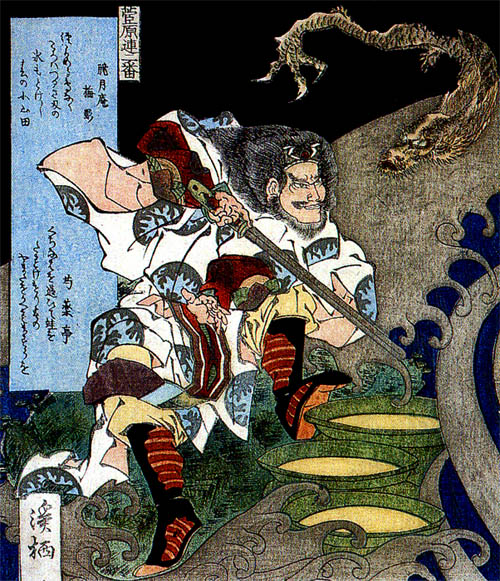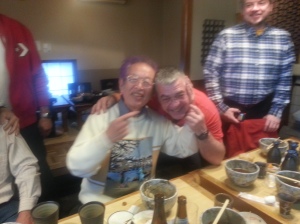This is Susanô who retrieved the original Kusanagi no Tsurugi from the tail of the hydra and gave it to his sister, who gave it later to Ninigi no Mikoto the first “godsend” ruler of Japan. This Tsurugi with the mirror and the jewel are the three regalia proving the divine mandate given to him. They are the symbol of the Imperial rule over Japan.
Ninigi’s great-grandson Jimmu, was to become the first Emperor.
Month: January 2014
得心 or 心得 (kokoroe 2)
 I do not speak Japanese but I love to “understand” the meaning of Japanese kanji.
I do not speak Japanese but I love to “understand” the meaning of Japanese kanji.
Kokoroe And Jihi no Kokoro
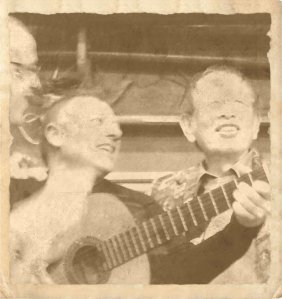 In Japanese 心得 knowledge is kokoroe. Interestingly it is made up of two kanji 心, “shin” which is kokoro (heart, mind) and 得, “u” that has the meaning of: to get; to acquire; to obtain; to earn; to win; to gain; to secure.
In Japanese 心得 knowledge is kokoroe. Interestingly it is made up of two kanji 心, “shin” which is kokoro (heart, mind) and 得, “u” that has the meaning of: to get; to acquire; to obtain; to earn; to win; to gain; to secure.
Gensô illusion

Wearing the ninja outfit doesn’t give you the abilities. The Omote side is nothing compared to the Ura side of reality. Too many of us forget that 幻想 Gensô Is illusion. This is the same as in Genjutsu, and the essence of Gen jutsu, for me, lies in 虚辞 kyojitsu. And remember that kyojitsu is the backbone of the bujinkan. 虚実皮膜, “the difference between truth and fiction in art being very subtle, Art abides in a realm that is neither truth nor fiction”.
Zero no Chikara – no power
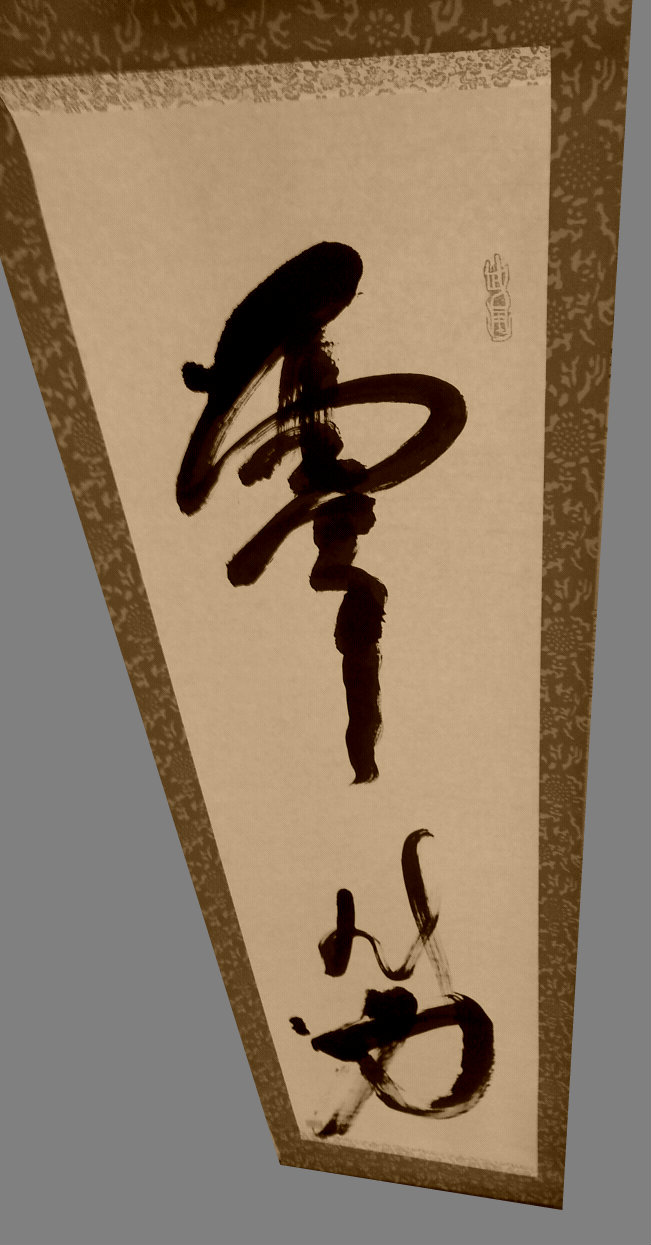
The theme for 2013 was mainly ken and mutô dori. Sensei ended the year by speaking a lot about “zero no Chikara” or “no strength” (picture).
But did you know that 力 chikara and 刀 sword are nearly written the same? -the vertical line protruding on top of the”ken”. Therefore strength and sword are linked; and if you are not using any strength then you achieve 無刀取り mutô dori.
By using no power you have unlimited power as 無刀取り mutô dori is having the courage to do what you have to do, whatever the outcome might be.
Juppô Sesshô series

The Juppô Sesshô is the expression of Ninpô Taijutsu. Hatsumi sensei began to expose it back in 2003. This 3-dvd series covers the first year of Juppô Sesshô dedicated to “Sanjigen no Sekai” or to be able to see the third dimension.
http://budomart.eu/index.php?controller=search&orderby=position&orderway=desc&search_query=jupp&submit_search=Search
A Fantastic Day (part 3)
A Fantastic Day (part 3)
Having lunch with sensei is always fun and the mix of beer, Sake and whisky made it even more memorable.
Sensei spoke a lot of the future of the bujinkan. The year 2014 is a new beginning, the beginning of a new 42-year cycle. This is why sensei announced that he will be with us until he reaches 120 years of age.
I am sure that Sensei will explain in the next months what he has in mind, so I let him explain it when the time comes. It will mainly concern the new honbu, a new office dealing with the bujinkan paperwork, the time for the jugodan to take responsibility for our organization.
But the main subject he unveiled is the necessity to befriend our fellow buyu from all over the world.
The bujinkan has been spreading in many countries over the past 42 years and there are no border. Bujinkan is a human art and humans are the same all over the world. Nationalism is not part of the bujinkan, we are all members of the same world.
As Sensei said last year: “Bujinkan Budô is made in human”, please don’t forget it.
At the end of the lunch we were all very “happy” including our host.
On the way back to Kashiwa we stopped at Starbucks for a few coffees and cakes with Pedro, Sheila, Gillian, Christian and many others. And here again there was a lot of happiness.
Thank you sensei for this fantastic day and for the depth of your teachings making us more adult and human.
Happy Birthday!
https://kumafr.wordpress.com/2014/01/04/a-fantastic-day-part-2/
A Fantastic Day (part 2)
Sensei at 84 moves like he is half this age. In fact he once again spoke about the 42-year cycle (see my blog on 42). Later during lunch he mentioned it again and repeated that this year is the end of a 42-year cycle. This end is the beginning of another one beginning next year. As a joke he added that this should let him reach 120 years of age!
When able to manifest this Mu no Kûkan the practitioner doesn’t apply any given waza. He is only surfing on the waves of intentions of the adversary. This is the third edge of the sanshin triangle detailed in the first part of this article. In fact the Sakki experienced during the Sakki test is the perfect illustration of this. The receiver and the emitter are somehow connected and the flow of energy is going both ways. You don’t give the sakki you connect yourself to the Sakki existing in any sentient being.
This is about relation. Without it the only thing happening is a bump on the head followed by a big headache.
Sensei spoke a lot about this connection. He said that once reactivated the Sakki should pulse permanently. The test is only there to reveal it to yourself. There’s no magic only natural understanding of what a human is. When you are in a middle of a fight you don’t fight. You control and secure every angle, but you keep a Mushin state of mind. You do not try to do anything. You don’t want to do anything specific.
Sensei going deeper in his explanations commented that it is important to hide your understanding and not to reveal yourself too much. Be aware that most of your daily fights will not be physical. They will happen at the if office, in your daily lives. If you do not develop this Sakki you’ll end up having an unhappy life.
For many years Hatsumi sensei has tried to make us accept and find happiness in our lives. In fact this is for me the most important part of his teaching. I will always remember this one class where he came to me during training and told me that he had decided to live a happy life. And he added: ” and you should try it too!”. Since then I’ve tried to be happier. It is not always simple but when you understand that happiness is often only a moment, then it is possible to get it.
A moment of happiness is similar to a cloudy sky. At some point the clouds split and you can enjoy the light of the sun for a few minutes. Learn to recognize these moments and to enjoy them.
A moment of happiness is exactly what he offered to a group of us yesterday after the class when we went to eat together in Noda. This was what made this day such a fantastic one.
Read here the last part A Fantastic Day (part 3)
https://kumafr.wordpress.com/2014/01/04/a-fantastic-day-part-3/
Thank You for the Magic, Sensei!
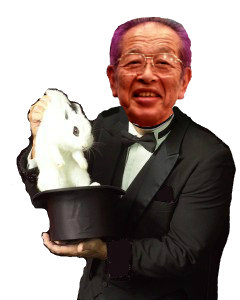 On the 28th of January 2014 we will be entering the year of horse of wood. This will be my third year of the horse in the Bujinkan like it has been the case on 27th of January 1990 and on the 12th of February 2002. I see this third occurrence as some kind of Sanshin.
On the 28th of January 2014 we will be entering the year of horse of wood. This will be my third year of the horse in the Bujinkan like it has been the case on 27th of January 1990 and on the 12th of February 2002. I see this third occurrence as some kind of Sanshin.Horse 1990. This is the year when I came to Japan for the first time and I experienced this as an epiphany. Everything I saw during my first stay in Japan inside and outside of the dojo was like magic: to train with Sensei in Japan; to meet with the Japanese Shihan; and to discover Japan and getting a taste of true Japanese culture.
His magic is revealed and demonstrated in each class. But how many bujinkan members are really able to see that what he is teaching us goes far beyond a mere collection of waza and fighting skills? Not so many I guess and this is a pity.
Nagare Is Important to Nagare
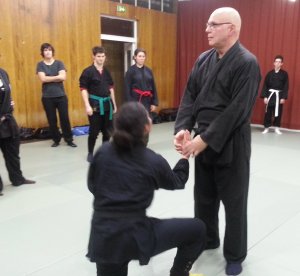 The year 2014 began a few days ago and after wishing everyone a happy new year it is time to get back to the dôjô.
The year 2014 began a few days ago and after wishing everyone a happy new year it is time to get back to the dôjô.
